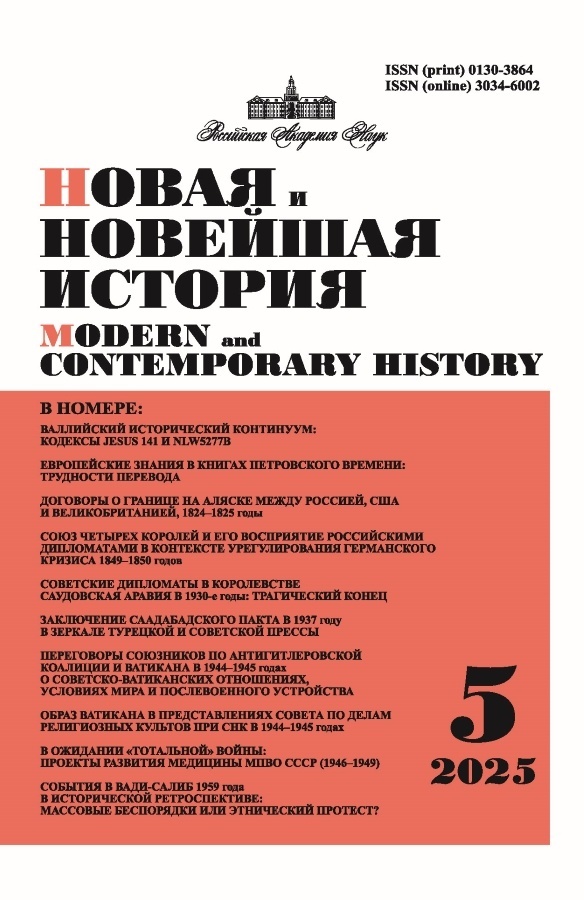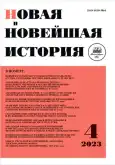“The Idea of New Munich is in the Air”: Italian Documents on Preparations for an International Conference in Late August 1939
- Authors: Mikhaylenko V.I.1
-
Affiliations:
- Ural Federal University
- Issue: No 4 (2023)
- Pages: 109-123
- Section: 20th century
- URL: https://gynecology.orscience.ru/0130-3864/article/view/670985
- DOI: https://doi.org/10.31857/S013038640024239-0
- ID: 670985
Cite item
Abstract
In the summer of 1939, Hitler's Germany provoked an acute European crisis, the outcome of which had several options for resolution, including a peaceful one, along the lines of the Munich Agreement of 1938. Adolf Hitler, with his strategy of indirect action, played for higher stakes, took risks and often bluffed, leaving it to himself to exploit the option that was most favourable for him. Since 22 May 1939, Fascist Italy had been a military ally of Germany. Depending on the outcome of the Polish-German conflict, the Italian leadership planned a local “parallel” war in the Balkans and the Mediterranean in the event that the Western allies failed to counter German plans. The study proves that the British and French declarations of war on Germany were aimed at preventing Italian aggression in the area of direct geopolitical interest of the UK and France. The author analyses attempts made by Italian diplomacy to organise a “new Munich” and the reasons for their failure. The author analyses attempts made by Italian diplomacy to organise a “new Munich” and the reasons for their failure. He concludes that the Western allies succeeded in preventing the actualisation of the Italian-German military alliance. This was done under the threat of a all-out war and a crushing blow to Italy and its colonial possessions. In the context of the immediate politico-military situation at the time, the holding of a peace conference proved irrelevant to both the German leadership and the Western allies. Analyzing the four powers' negotiation process with regard to convening a peace conference, the author believes that prior to 17 September 1939, the USSR was hardly considered as an independent factor in the diplomatic and military game of the European powers. The author's conclusions are supported by data from Italian diplomatic and military documents, previously unknown in Russian historiography.
References
- Бочаров И.Н. Дипломатия фашистской Италии в канун Второй мировой войны (май–август 1939): дис. … канд. ист. наук. М., 1973.
- Гроссман А.С. «Ось» Берлин – Рим и начало Второй мировой войны // Вопросы истории. 1968. № 8. С. 80–98.
- Жерко С. Внешняя политика Германии накануне Второй мировой войны // Волос М., Войтковяк Я., Дашичев В.И. и др. Международный кризис 1939 года в трактовках российских и польских историков / под ред. М.М. Наринского, С. Дембского. М., 2009. С. 101–148.
- Капитонова Н.К. Политика Великобритании от Мюнхена до пакта Риббентропа ‒ Молотова (от «умиротворения» к политике гарантий) // Волос М., Войтковяк Я., Дашичев В.И. и др. Международный кризис 1939 года в трактовках российских и польских историков / под ред. М.М. Наринского, С. Дембского. М., 2009. С. 207–237.
- Лиддел Гарт Б. Стратегия непрямых действий. М.; СПб, 2008.
- Майский И.М. Дневник дипломата. Запись от 26 августа 1939 года // URL: https://www.phantastike.com/history/dnevnik_diplomata_1/djvu/view/ (дата обращения: 09.08.2022).
- Михайленко В.И. «Параллельная» стратегия Муссолини. Т. 1. Фашистская Италия в Версальской системе (октябрь 1922 – август 1939). Екатеринбург, 2013.
- Михайленко В.И. Итальянская литература о политике держав оси Берлин ‒ Рим на Балканах (1939‒1940) // URL: https://elar.urfu.ru/bitstream/10995/41640/1/balkan_1977_07.pdf (дата обращения: 10.08.2022).
- Фальсификаторы истории (историческая справка) М., 1948.
- Хавкин Б.Л. К истории публикации советских текстов советско-германских секретных документов 1939–1941 гг. // Форум новейшей восточноевропейской истории и культуры. 2007. № 1. С. 1–19.
- Чиано Г. Дневник фашиста, 1939‒1943. М., 2010.
- Чубарьян А.О. ХХ век: взгляд историка. М., 2009.
- Diario Storico del Comando Supremo. Vol. 1. T. 2 / a cura di A. Biagini e F. Frattolillo. Roma, 1986.
- Faldella E. L’Italia nella seconda Guerra mondiale. Revisione di giudizi. Bologna, 1959.
- François-Poncet A. A Palazzo Farnese. Memorie di un Ambasciatore a Roma. 1938–1940. Firenze, 2009.
- Gabriele M. 1939. Vigilia di Guerra nel Mediterraneo // Rivista Marittima. Luglio, 1984. P. 17–40.
- Gabriele M. Operazione C3: Malta. Roma, 1975.
- Gin E. L’ora segnata dal destino. Gli Alleati e Mussolini da Monaco all’intervento. Settembre 1938 – Giugno 1940. Roma, 2012.
- Hitler e Mussolini. Lettere e documenti. Milano, 1946.
- Il Patto Ribbentrop – Molotov. L’Italia e l’Europa (1939–1941). Atti del Convegno (Roma, 31 maggio – 1 giugno 2012) / a cura di A. Basciani, A. Macchia, V. Sommela. Roma, 2013.
- Minniti F. Fino alla Guerra. Strategie e conflitto nella politica di Potenza di Mussolini. 1923–1940. Napoli, 2000.
- Mosca R. L’Europa verso la catastrofe. Vol. 2. Milano, 1964.
- Nazi-Soviet Relations. 1939–1941. Documents from the Archives of the German Foreign Office / eds R.J. Sontag, J.S. Beddie. Department of State, 1948.
- Playfair I. S.O. The Mediterranean and Middle East. Vol. 1. London, 1954.
- Toscano M. Le origini diplomatiche del Patto d’Acciaio. Firenze, 1956.
- United States and Italy 1936‒1946. Documentary Record. Washington, 1946.
Supplementary files








